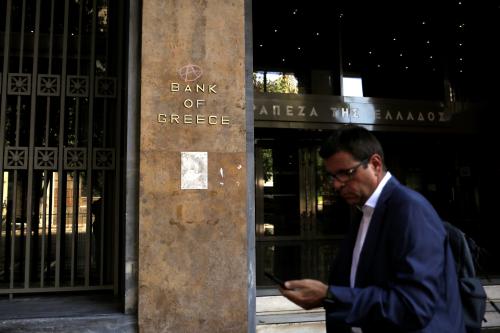On Friday, April 20, senior officials representing the International Monetary Fund, the European Stability Mechanism, and the European Central Bank as well as key eurozone finance ministers met to discuss Greek debt-lightening as well as to decide what to do with post-bailout Greece. Then, on April 27, the Eurogroup convened in Sophia, Bulgaria, to discuss rules for post-program surveillance and the next steps for official sector involvement (OSI), the technical term for debt relief involving the public sector. Prior to taking any post-program surveillance and OSI decisions, the Eurogroup reassured creditors that Greece will first be required to fulfill outstanding prior actions as stipulated in the ongoing third program. With 88 prior actions remaining, the program is far from complete and the timetable ahead is extremely tight.
Greek Finance Minister Euclid Tsakalotos, in an April 27 interview with the Financial Times, admitted that, once the post-bailout period begins after August 20, 2018, “EU monitoring missions would probably be more frequent than the twice-yearly assessments that are standard in post-bailout countries. It is likely to be a case of three or four visits instead of two.” In other words, in exchange for OSI, surveillance will be enhanced to confirm that reforms continue. Tsakalotos is actually at odds with Prime Minister Alexis Tsipras who talks about a “clean exit,” meaning a post-August 2018 period without any creditor-dictated obligations or conditions applicable to the country and his government in particular.
Clearly, a new hybrid-agreement orchestrated by the European Stability Mechanism, European Central Bank, European Commission, and IMF to supervise Greece after August 2018 is emerging. Its aim is to ensure that either the current or the next government(s) complies with the rules. One other thing is certain: This time the terminology has to change. Nobody wants to hear again words like austerity, memorandum, a new bailout, nor do they want to read opinion article about how costly program failures are hurting European taxpayers.
As for the way forward, the current Shakespearian drama involves two options that once again place Greece again between Sculla and Harybdis, or rock and a hard place. The least onerous, called the “French key” is linked to future nominal growth rates with debt payback tranches; the hard one links gradual debt relief with conditionality measures—in other words, more reforms. The second now looks more likely. Meanwhile, the IMF is pushing for more upfront and unconditional debt-lightening, being rather skeptical of both the European Commission/French gradual approach and the German/Dutch conditional debt relief. This IMF position further complicates the state of play.
In a nutshell, this time everyone needs to project some degree of satisfaction, for three reasons:
- With European elections set for May 2019, eurozone politicians need to tell voters that the Greek program has at last succeeded.
- The Greek Syriza radical left government needs to signal to voters that an exit to the markets is feasible—i.e., clean exit—and the time to leave behind austerity has come (in fact the government is organizing a party in Syntagma Square to celebrate the “markexit”—proof that at least populism in my country entails some fun).
- Last but not least, the IMF needs to convince the world that it can always play a constructive and critical role, even as a watchdog, since it chose to opt out of the third bailout program.
A credit line to support the country to borrow from the markets at lower rates is now definitely excluded. Securing such an option would require passage by numerous eurozone national parliaments, something currently not viable. That would be like confessing that even the third bailout program was a failure.
Since the only game in town is for all players to go through the motions of a clean exit—what remains is to identify a magic formula to bridge the differences among creditors regarding key longer-term parameters. These include as agreement on trend growth rates and primary budget surpluses, which will determine debt sustainability. It is critical for the accord to signal to markets that the level of OSI will allow Greece to borrow at a rate that will not lead to unsustainable debt in the future.
The IMF’s latest World Economic Outlook trimmed the forecast for Greece’s growth, now projecting the economy to expand by 2.0 percent in 2018, down from 2.6 percent in an earlier forecast. Inflation is projected at around 0.7 percent in 2018 rather than 1.3 percent forecast earlier. Growth projections until 2022 are less than 2 percent. It is now clear that the Greek economy, despite 10 years of depression, cannot expand significantly. Growth rates are particularly anemic and certainly insufficient to generate new jobs, higher incomes, and make debt sustainable in the long-term.
Last week also, Poul Thomsen, director of the IMF’s European department accepted that sky-high taxes have hit growth rates. Meanwhile, Managing Director Christine Lagarde said that public expenditures have been radically reduced to meet (and exceed) the targets of the program, a development she said was not attributable to adherence to IMF advice—rather it was a policy choice of the Greek government. After all, one is wondering why Greece was really under close supervision over the past three years and at the same time the Greek government enjoyed some free space in fiscal policy (which, by the way, for a radical left government, was surprisingly austere). Keep in mind that primary surpluses for 2016 and 2017 rocketed to 4 percent and 4.2 percent respectively, thanks to sky-high taxes and social security contributions.
On the same note, Greece’s January-March 2018 primary budget was 2.3 billion euros, more than 1.2 billion above expectations, thanks in part to lower-than-forecast public investment. In contrast, for January and February 2018, overdue private debt increased by 2.6 billion euros. Which brings us to the core of the problem that the institutions and creditors seem to (or pretend to) ignore: Large primary surpluses bankrupt the private economy and dampen growth rates. The country’s 2 billion euro current account deficit in January and February 2018 further supports this point. Investments are less than capital depreciation—now only 11 percent of GDP—which is the worst number in eurozone. As a result, productivity keeps worsening.
So, yes, what is needed right now is maybe some more “financial engineering” of the debt profile to match these developments. More importantly, one has to see what tax burden the country can bear given its situation, taking into consideration the need to encourage new investment.
Part of what makes the debt workout so dysfunctional is that nobody talks about the fallout on taxpayers and on the country’s investment prospects during high stakes financial meetings about Greece’s future.
In this context, Greece is again between Sculla and Harybdis as it is condemned to inadequate growth rates that will always neutralize or cancel any temporary debt-lightening arrangements. For a real clean exit, one would expect the adoption of real measures to tackle heavy taxation and dis-investment instead of strangling the real economy to meet an unrealistic 4.2 percent primary surplus.
Yet these measures may not yet have the support of key EU protagonists, as an April 23 tweet by Valdis Dobrovskis, the EU Commission’s vice-president for the euro and social dialogue and official in charge of financial stability, financial services, and capital markets union made clear:
Positive news on #Greece: new #Eurostat data show that Greece has again outperformed its fiscal targets. In 2017, the primary surplus in programme terms has reached 4.2% of GDP instead of 1.75% of GDP target. Good news in the view of the programme conclusion in August! pic.twitter.com/b8Z4XN7nRK
— Valdis Dombrovskis (@VDombrovskis) April 23, 2018
To conclude, debt sustainability comes only when nominal growth is strong. This, in turn, is an output of permanently high investments rates and low taxation. Only after that will high primary surpluses arise naturally as a consequence of growth. It’s economics 101.
The Brookings Institution is committed to quality, independence, and impact.
We are supported by a diverse array of funders. In line with our values and policies, each Brookings publication represents the sole views of its author(s).






Commentary
Greece’s Sisyphean drama: From Grexit to exit to the markets?
May 2, 2018